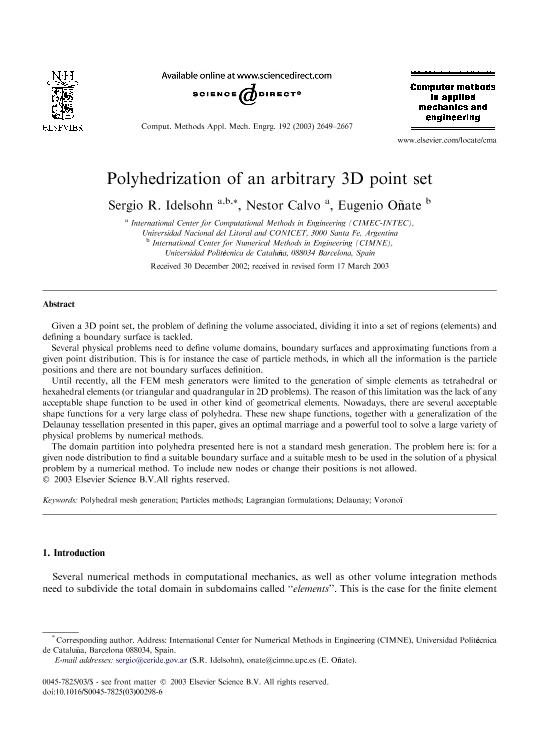Mostrar el registro sencillo del ítem
dc.contributor.author
Idelsohn, Sergio Rodolfo

dc.contributor.author
Calvo, Nestor Alberto

dc.contributor.author
Oñate, Eugenio
dc.date.available
2017-11-02T13:13:36Z
dc.date.issued
2003-12
dc.identifier.citation
Idelsohn, Sergio Rodolfo; Calvo, Nestor Alberto; Oñate, Eugenio; Polyhedrization of an arbitrary 3D point set; Elsevier Science Sa; Computer Methods in Applied Mechanics and Engineering; 192; 12-2003; 2649-2667
dc.identifier.issn
0045-7825
dc.identifier.uri
http://hdl.handle.net/11336/27373
dc.description.abstract
The extended Delaunay tessellation (EDT) is presented in this paper as the unique partition of a node set into polyhedral regions defined by nodes lying on the nearby Voronoï spheres. Until recently, all the FEM mesh generators were limited to the generation of tetrahedral or hexahedral elements (or triangular and quadrangular in 2D problems). The reason for this limitation was the lack of any acceptable shape function to be used in other kind of geometrical elements. Nowadays, there are several acceptable shape functions for a very large class of polyhedra. These new shape functions, together with the EDT, gives an optimal combination and a powerful tool to solve a large variety of physical problems by numerical methods. The domain partition into polyhedra presented here does not introduce any new node nor change any node position. This makes this process suitable for Lagrangian problems and meshless methods in which only the connectivity information is used and there is no need for any expensive smoothing process.Given a 3D point set, the problem of defining the volume associated, dividing it into a set of regions (elements) and defining a boundary surface is tackled.
Several physical problems need to define volume domains, boundary surfaces and approximating functions from a given point distribution. This is for instance the case of particle methods, in which all the information is the particle positions and there are not boundary surfaces definition.
Until recently, all the FEM mesh generators were limited to the generation of simple elements as tetrahedral or hexahedral elements (or triangular and quadrangular in 2D problems). The reason of this limitation was the lack of any acceptable shape function to be used in other kind of geometrical elements. Nowadays, there are several acceptable shape functions for a very large class of polyhedra. These new shape functions, together with a generalization of the Delaunay tessellation presented in this paper, gives an optimal marriage and a powerful tool to solve a large variety of physical problems by numerical methods.
The domain partition into polyhedra presented here is not a standard mesh generation. The problem here is: for a given node distribution to find a suitable boundary surface and a suitable mesh to be used in the solution of a physical problem by a numerical method. To include new nodes or change their positions is not allowed.
dc.format
application/pdf
dc.language.iso
eng
dc.publisher
Elsevier Science Sa

dc.rights
info:eu-repo/semantics/openAccess
dc.rights.uri
https://creativecommons.org/licenses/by-nc-sa/2.5/ar/
dc.subject
Delaunay
dc.subject
Lagrangian Formulations
dc.subject
Particles Methods
dc.subject
Polyhedral Mesh Generation
dc.subject.classification
Ingeniería Oceanográfica

dc.subject.classification
Ingeniería del Medio Ambiente

dc.subject.classification
INGENIERÍAS Y TECNOLOGÍAS

dc.title
Polyhedrization of an arbitrary 3D point set
dc.type
info:eu-repo/semantics/article
dc.type
info:ar-repo/semantics/artículo
dc.type
info:eu-repo/semantics/publishedVersion
dc.date.updated
2017-11-01T16:40:43Z
dc.journal.volume
192
dc.journal.pagination
2649-2667
dc.journal.pais
Estados Unidos

dc.description.fil
Fil: Idelsohn, Sergio Rodolfo. Consejo Nacional de Investigaciones Científicas y Técnicas. Centro Científico Tecnológico Conicet - Santa Fe. Instituto de Desarrollo Tecnológico para la Industria Química. Universidad Nacional del Litoral. Instituto de Desarrollo Tecnológico para la Industria Química; Argentina
dc.description.fil
Fil: Calvo, Nestor Alberto. Consejo Nacional de Investigaciones Científicas y Técnicas. Centro Científico Tecnológico Conicet - Santa Fe. Instituto de Desarrollo Tecnológico para la Industria Química. Universidad Nacional del Litoral. Instituto de Desarrollo Tecnológico para la Industria Química; Argentina
dc.description.fil
Fil: Oñate, Eugenio. Universidad Politecnica de Catalunya; España
dc.journal.title
Computer Methods in Applied Mechanics and Engineering

dc.relation.alternativeid
info:eu-repo/semantics/altIdentifier/url/http://www.sciencedirect.com/science/article/pii/S0045782503002986
dc.relation.alternativeid
info:eu-repo/semantics/altIdentifier/doi/http://dx.doi.org/10.1016/S0045-7825(03)00298-6
Archivos asociados
